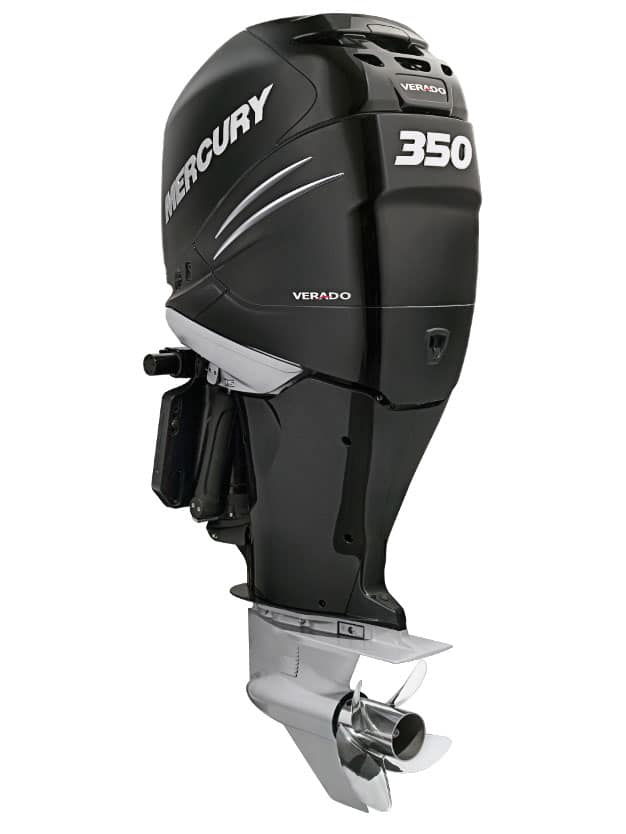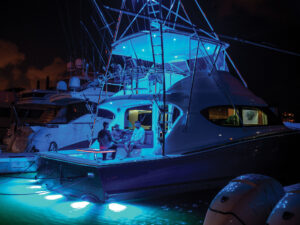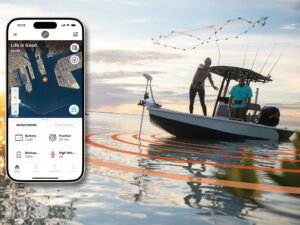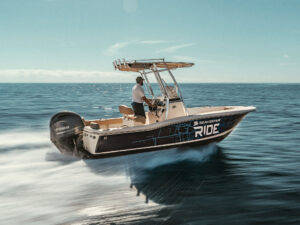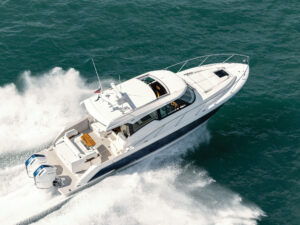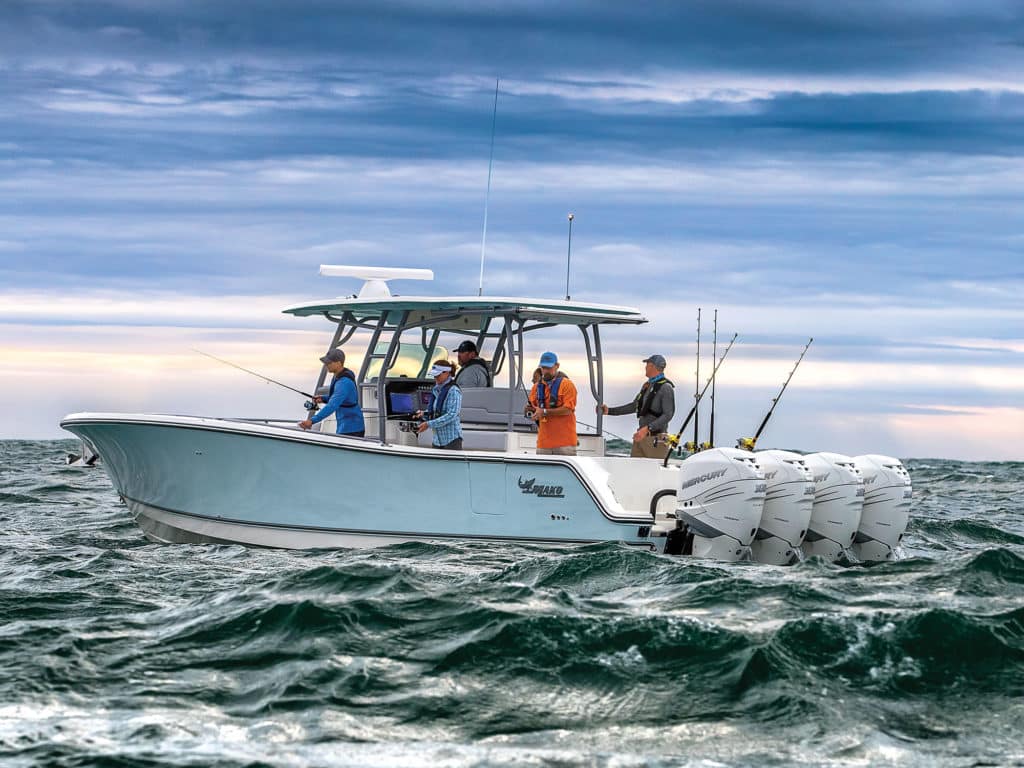
On a steady path to rekindling the widespread passion for the fabled shark-silhouette brand, Mako draws from its 50 years of boatbuilding expertise to meet the demands of offshore- angling devotees, which continue to grow along with the size of today’s center consoles.
While a lot has changed since the 1970s and ’80s when 17- to 25-foot Mako boats were staples of the sport-fishing scene throughout the Southeast, the 334 CC launched a year ago was a loud declaration of the brand’s intent to reclaim its place among the leaders, and the recent debut of the 414, Mako’s largest model to date, reiterates the company’s commitment to expand beyond previous boundaries.
Featuring a 24-inch deadrise for a softer ride, lifting strakes for high performance, and a set-back transom to deliver undisturbed water to the props, the deep-V hull boasts 100 percent composite construction and a one-piece, foam-injected stringer grid with integrated transom knee supports for high strength-to-weight ratio and maximum rigidity. The hull-deck joint is chemically sealed and bonded, stainless-steel fasteners every 6 inches add to the soundness and integrity, and all cleats, chocks and hinges have aluminum backing plates.
The wealth of attributes begins at the front with a through-hull breastplate and roller holding a 35-pound stainless anchor, and an anchor locker that hides a windlass and stores 600 feet of rode. Raised compartments afford 59 quarts of dry-storage on both sides of the bow, and, a step aft, a cavernous 824-quart chamber stows fenders, buckets and other large items below deck. For safety, recessed handrails stretch along both covering boards, from the bow to the helm, and coaming bolsters border the top of the gunwales and transom.
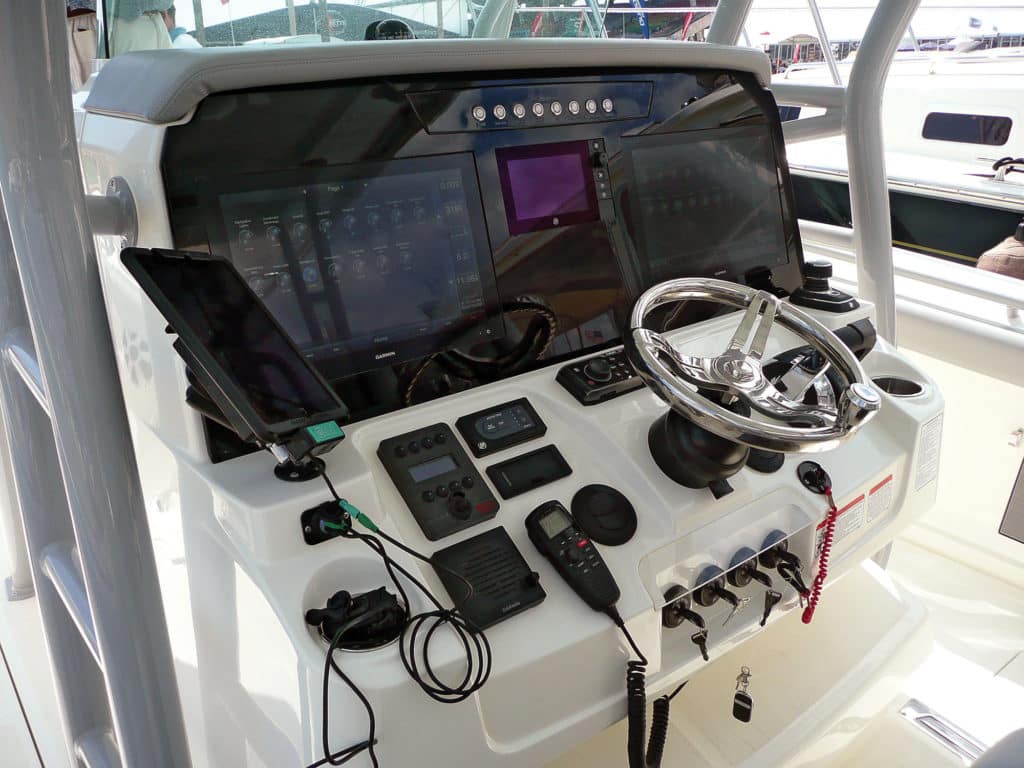
There are flush-mounted holders for eight rods, and horizontal racks cradle six more. Large in-floor fish boxes, a telltale sign of a hardcore offshore fishing machine, parallel the gunwales — two 455-quart boxes at midship and two 511-quart boxes (with macerators and overboard discharge) in the cockpit, their dimensions well-suited for icing down trophy-size pelagics. Strategically located on the transom corners, identical 50-gallon livewells with blue interiors, clear lids, and steady water flow from a four-pump sea-chest setup are further evidence that input from experienced anglers played a major role in the design of this center console. Although the big Mako is undeniably built for serious fishing, it doesn’t lack creature comforts. For starters, seating goes well beyond the functional. Cushions and removable backrests turn twin compartments at the bow into comfortable loungers. A removable table between them converts the front of the boat into a social zone, or a filler panel bridges the gap to form a full sun pad instead. Jump seats pull down from the port and starboard gunwales, then fold up flush so they won’t impede foot traffic. Wider versions of the jump seats hide in the rear bulkhead, accommodating six crew members on the way to and from the fishing grounds, and stow away when it’s time to set out lines.
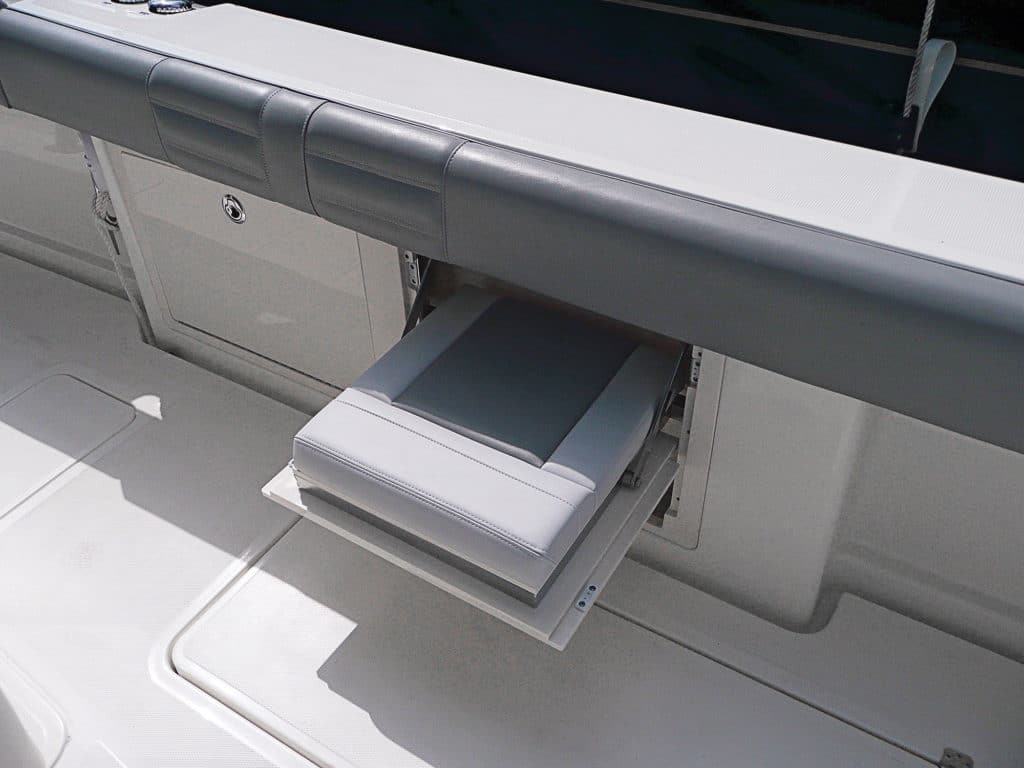
A pair of loungers with fold-down armrests and a 275-quart cooler underneath stretch forward of the console. A door to starboard provides entry to a stand-up head compartment inside the console, complete with a pull-out shower, sink, toilet, bunk and storage cabinets.
As you’d expect on a boat this size, the console, aided by a tempered-glass windshield and a deluxe hardtop with built-in electronics boxes, lighting, a shade that extends aft to cover the cockpit, and access on both sides for an optional second helm above, offers substantial protection from the elements. The dash accommodates two 17-inch multifunction displays, plus digital gauges and CZone digital switching with Mako’s exclusive SharkTooth moni-toring app. The steering wheel, set on the centerline, leaves room for a VHF, stereo, trim-tab switches and more.
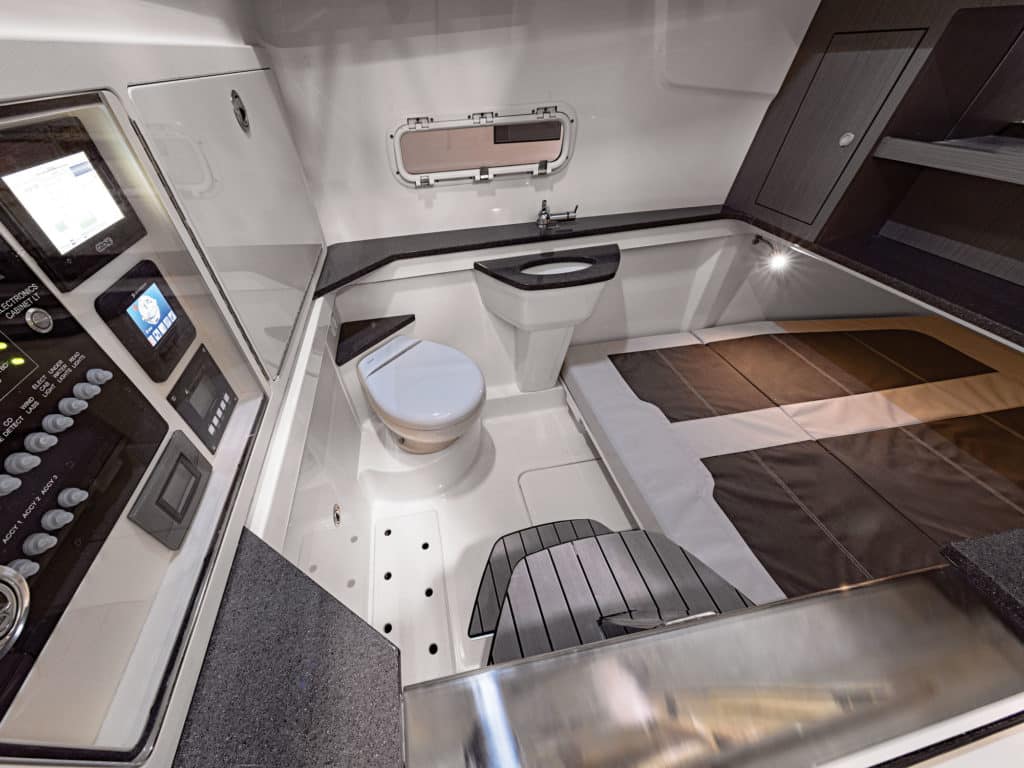
Three adjustable bolster seats with arm- and footrests serve as helm seating, with a rigging station in back (upgradeable to a summer kitchen), plus a full complement of storage hatches and drawers behind and below. If that’s not enough tackle storage, four tilt-out hatches hide tackle trays and tool and leader-spool holders.
Like the 334 before it, the 414 CC is available in two configurations: Bluewater Family and Sportfish editions, with options such as Mercury Joystick Piloting, Iris NightRunner infrared camera, cooktop and refrigerator in the leaning post, on-demand water heater, tuna/dive door with boarding ladder and more.
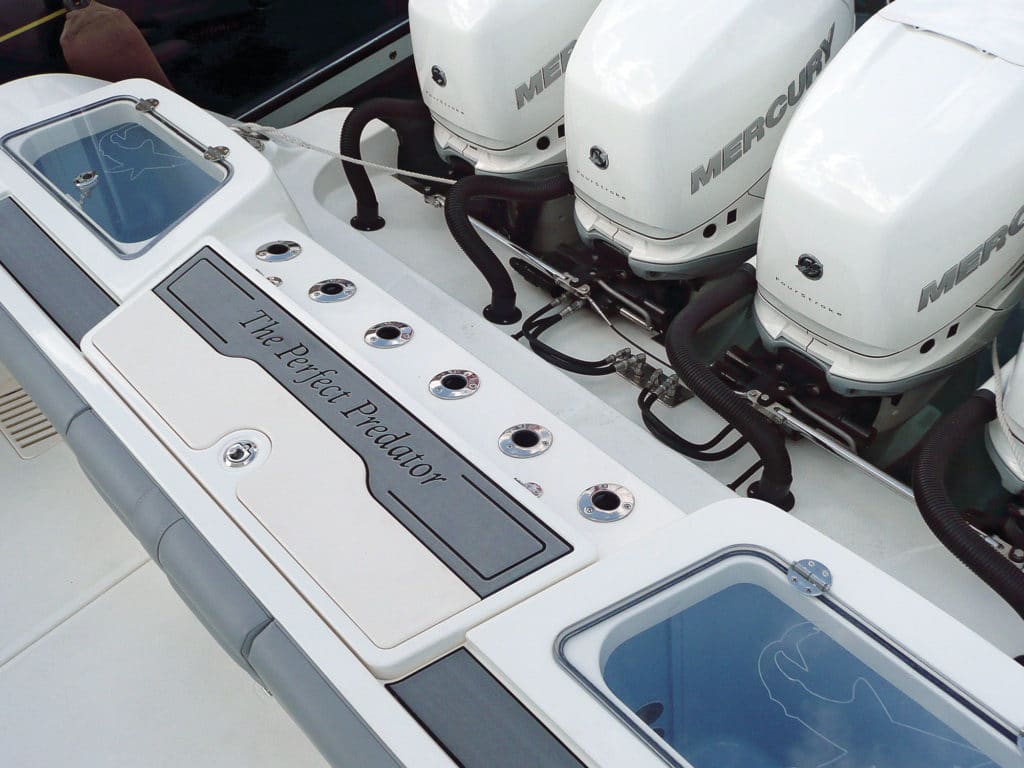
Boat survey completed, the 20-knot blow and 4-foot chop that greeted us in south Biscayne Bay helped put the 41-footer to the test. Powered by quad 350 Verados, we jumped on plane, went from zero to 30 mph in 8 seconds without the bow ever rising above eye level, and topped out at a plenty-fast 59 mph.
Despite its heft and large footprint, the Mako seemed to ride the crests of the waves rather than slicing through them, feeling nimble and responsive while taking on the chop matter-of-factly at different speeds and in every direction, and never forcing a wince out of me. It also tracked well on tight turns, and sea spray, a fact of life under the existing conditions, started aft of the helm where it had little chance to make it over the gunwales.
The 414 CC combines sleek and efficient design below and above the waterline with top-notch fit and finish, the latest in marine technology, an ergonomic layout and smart use of all the interior space afforded by its ring-deck design. I found it solid, comfortable, quick and fun to ride. If you’re looking for a boat in its class, don’t overlook this bad boy.
